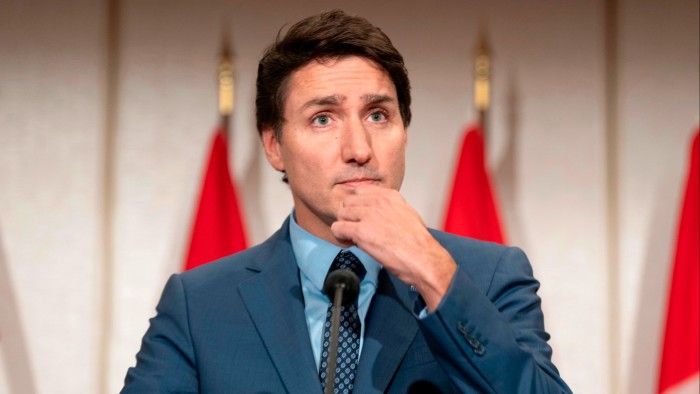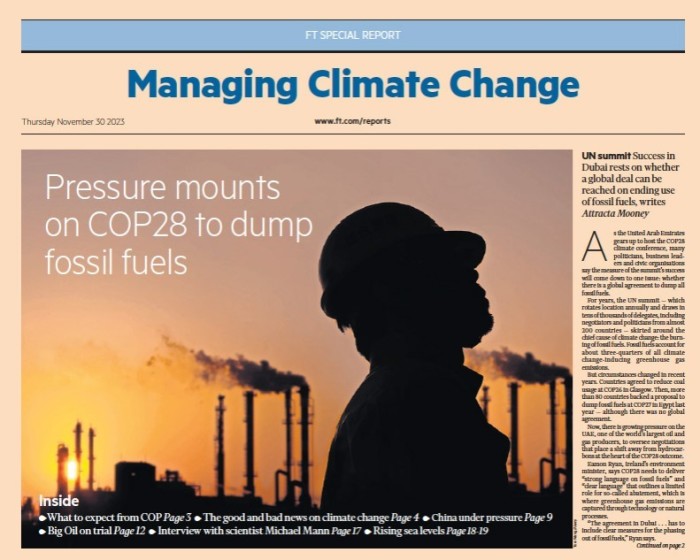Why putting a price on carbon has been fraught with difficulty

Roula Khalaf, Editor of the FT, selects her favourite stories in this weekly newsletter.
“Axe the tax” has become the rallying cry for political opponents of Justin Trudeau, Canada’s prime minister. Last month, they forced him into an embarrassing climbdown over his flagship climate policy.
Canada’s carbon pricing system, in place since 2019, is seen as a test case of how to win voters’ support for a green transition that carries costs for consumers in the short term. It gives each province and territory the freedom to design its own system, with the proceeds — set to rise over time, in line with the federal price on pollution — collected locally and returned to households through a system of rebates.
But, despite this design, the levy remains so unpopular that Trudeau was pressured into agreeing a three-year delay to its imposition on home heating oil, in order to keep alive his chances of re-election in 2025.
Trudeau’s travails show how difficult it remains to win public acceptance for policies that impose the upfront costs of the net zero transition on households and companies already struggling with high inflation.
Other leaders are similarly hesitant. In France, president Emmanuel Macron, stung by the gilets jaunes protest movement that began in 2018 over fuel taxes, has called for a “regulatory pause” on new green measures. In the UK, Prime Minister Rishi Sunak has delayed bans on the sale of new gas boilers and new petrol and diesel cars.
All this comes in the context of a drive by US President Biden’s administration to turn the green transition into a vote-winning, job-creating juggernaut — by pouring taxpayer money into subsidies for clean energy investment.
This subsidy-driven approach has alarmed some economists, because it looks likely to be a vastly more expensive method of achieving climate goals than market-driven mechanisms.
“It sounds so much nicer, but the numbers just don’t work out . . . The state doesn’t have deep enough pockets to pay for all of the decarbonisation we need,” says Georg Zachmann, a senior fellow at Bruegel, a Brussels-based economic think-tank.
For years, economists have been urging governments to put a price on carbon — via taxes or emissions-trading systems — as the most cost-effective way to spur investment in decarbonisation, encourage energy efficiency, and create a level playing field for companies adopting clean technology.
In October, the IMF warned that the fiscal cost of tackling climate change could be “unsustainable” without a tax on pollution. Vitor Gaspar, IMF director of fiscal affairs, said that “scaling up the current policy mix, heavy on subsidies and other components of spending” could raise public debt in a typical economy by 40-50 percentage points of gross domestic product by the middle of this century.
But any global deal to set a carbon price — or even adopt the IMF’s suggestion of a looser minimum price floor for big emitters — remains an elusive goal.
“It’s the theoretical ideal, but it’s practically infeasible,” says Misato Sato, a research fellow at the Grantham Research Institute on Climate Change and the Environment.
An annual stock-take by the World Bank found that direct carbon-pricing mechanisms — whether taxes, credits or emissions trading systems — covered just 23 per cent of global greenhouse gas emissions in 2023, up from 7 per cent a decade ago but very little changed from 12 months earlier.

This article is part of an FT special report on Managing Climate Change
More worryingly, less than 5 per cent of global emissions were covered by a price high enough to drive investments at the scale and pace needed and, in many countries, carbon prices did not keep pace with inflation.
This means the effect of carbon taxes and trading is still “dwarfed” by the impact of traditional fuel excise duties and fossil fuel subsidies worth more than $1tn a year, the World Bank said.
Yet economists believe that, despite this sluggish progress, there are grounds for optimism, with a growing recognition that carbon pricing needs to be part of a mix of policies, combined with regulation, subsidies to spur innovation, and fiscal help for poorer households and countries to adjust.
Developing countries should not yet be expected to burden their economies with carbon prices as high as those already in place in the EU, since they did not bear the same responsibility for past emissions, argues Simone Tagliapietra, a senior fellow at Bruegel.
China’s nascent emissions trading scheme does not yet have a broad enough scope or a high enough price, notes Zachmann — but it could be ramped up in future, and is already prompting other big emitters in the region, including India and Indonesia, to develop their own strategies.
Sato says the EU’s policy of returning revenues from its emissions trading schemes to member states, to be spent on climate-related activities, has “visibly worked to buy political support for those schemes”.
Meanwhile, the EU’s new Carbon Border Adjustment Mechanism — which, from 2026, will tax carbon-intensive imports from countries outside the bloc that have weaker climate regulations — could spur some key trade partners into action. But, as the EU extends its pricing regime to areas that affect voters more directly, such as transport and buildings, it is increasingly important to channel the revenues into protecting poorer households and helping those on middle incomes to take up greener alternatives, says Tagliapietra.
“Carbon pricing should go hand in hand with carbon dividends . . . Without carbon dividends, it is socially and politically unsustainable,” he says.
Climate Capital

Where climate change meets business, markets and politics. Explore the FT’s coverage here.
Are you curious about the FT’s environmental sustainability commitments? Find out more about our science-based targets here

Comments